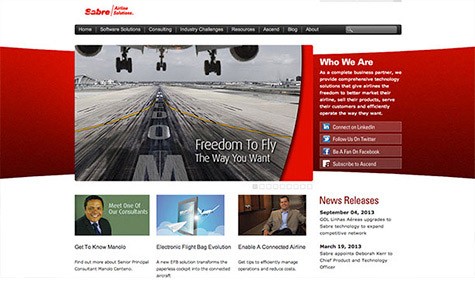To Evolve Your Business, Take Others on Your Journey
When Hugh Jones joined Sabre Airline Solutions as the company’s president in 2011, he was joining an organization that had experienced significant market-leading growth. Still, the company was facing the daunting task of continuing the growth of its software portfolio in the face of a finite market — there are roughly 800 airlines globally.
 An airline software and consulting solutions company that helps airlines market, sell, serve, and operate — basically, anything an airline needs to run other than the aircraft and the runway — Sabre Airline Solutions had recently signed agreements with several airlines, including LAN, Virgin America, Etihad, Philippine Airlines, and JetBlue. While Travelocity saw revenue constriction, the company’s airline software division helped push Sabre Holdings revenues past the $3 billion mark, according to several analyst reports.
An airline software and consulting solutions company that helps airlines market, sell, serve, and operate — basically, anything an airline needs to run other than the aircraft and the runway — Sabre Airline Solutions had recently signed agreements with several airlines, including LAN, Virgin America, Etihad, Philippine Airlines, and JetBlue. While Travelocity saw revenue constriction, the company’s airline software division helped push Sabre Holdings revenues past the $3 billion mark, according to several analyst reports.
When Sabre Holdings went private in 2007, Sabre Airline Solutions brought in roughly $250 million. When Jones took over, that number was closer to $400 million. Today, revenues are roughly $600 million, according to a source familiar with the company.
So, if things were going well, then why was new leadership brought in? Sometimes it takes a new perspective to take the next steps. That’s what Jones has been tasked with.
As we wrap up the first year of publication of Insigniam Quarterly we sat down with Jones and talked a bit about Sabre Airline Solutions. Not surprisingly, our conversation lined up with the themes of each of the first four issues of IQ — innovation, enterprise transformation, strategy and growth, and disruptive leadership.
INNOVATION: SHIFT FROM AN INSIDE-OUT VIEW TO ONE THAT’S OUTSIDE-IN
One of the changes that Jones has made at Sabre Airline Solutions has been foundational to the way the company approaches business. It’s a cultural shift from a deal-led mentality to a market-led mentality and it starts with rethinking how the company packages its offerings.
The company has three main software solution groups in its portfolio, 13 solution families, and up to 120 individual software and services offerings, depending on how you want to define them. To maximize a portfolio of that size you have to make sense out of it all, to find the leverage of having these assets.
“To us that’s a fundamental shift, or transformation, in what we are trying to do,” says Jones. “It really does kind of shift you from an inside-out to outside-in [approach]. Therefore, you begin the process of surveying the market, talking to customers, and understanding the trends, what does the competitive set look like, what are your capabilities?”
It’s the inside-out approach that Jones says keeps so many companies from executing on innovation. For example, in this year’s Insigniam Executive Sentiment survey, 87 percent of the leaders we spoke with told us that innovation was vital to the success of their enterprise. Still, only 15 percent said they were ready to execute on that innovation.
Jones says the chief problem those companies are having is one of perspective. Coming up with a good idea isn’t hard, Jones says. Most companies have lots of those. The problem is companies are trying to shoehorn these good ideas into a market that doesn’t want or need them. The ideas solve a problem that doesn’t exist. It’s innovation from an inside-out perspective, and that’s why the execution is such a headache.
“I think one of the things that companies struggle with is taking an idea from the inside and trying to find a market for it,” he says. “Just having an idea isn’t good enough. Perhaps a better approach is determining what market problem are you trying to solve, or what problems do your customers have that they would find value in someone solving on their behalf?”
It’s that need to problem solve that has Jones innovating the perspective at Sabre Airlines Solutions. Shifting to a portfolio model allows the company to offer the client end-to-end solutions, instead of solving just single problems. You have more ownership of their technology.
“We are always evolving our solution strategies and culminating in a new portfolio strategy for the business, and that, to me, is the ultimate customer promise we’ve been pursuing with Airline Solutions. How do you take an incredible set of assets and gain as much leverage out of them that you can, and, at the same time, solve your customer’s issues, creating value for them in a way that you haven’t been able to do it before?”
TRANSFORMATION: PAINT A CLEAR PICTURE OF THE FUTURE AND HOW TO GET THERE
Jones says a fundamental shift in the organization’s culture from one mentality to another is the kind of move that sometimes needs to be seeded with new blood. It doesn’t mean wholesale changes in personnel, but often to get a change like this to take root there needs to be new employees who can lead others in the organization through the transformation.
“In changing a culture of an organization in order to facilitate a transformation, you have to show them what it looks like,” Jones says, “not only the future, but you have to show them along the way tangible examples of what it means.”
It’s placing signposts along the way to let people know that the transformation is still on course, that things are still moving forward in the direction that they are supposed to that makes a transformation ultimately successful. That’s especially important in an organization that faces immense competitive pressure, like Sabre Airline Solutions.
Even though the company was already heavily penetrated, there was still room for growth. But growing like Jones wanted to grow — doubling the business in four years — was going to take a transformation, a shift in approach, a divergence from business as usual.
If there’s one thing we’ve learned from a year of producing Insigniam Quarterly and talking to world-class leaders, it is that people matter. And perhaps saying we learned that people matter is unfair. We have known that people matter. But finding out just how much of a role leaders believe people play in all aspects of a business’ success was eye opening.
For Jones and many other leaders, the key to transformation is people believing in the future that the leader sees for his or her company. The people who are going to be executing the transformation have to buy in, and getting them to buy in is the job of the leader whose vision the company is following.
“There’s no secret sauce here,” Jones says. “What do you want the future to look like? Can you paint what that future looks like? What are those tangible steps that can get to that future, and how do you align people to those steps? Then as you’re moving through them, you obviously have to have the capabilities and the folks to get you there, how do you communicate the successes and communicate the failures? And use those again as examples of ‘this is what we are striving for’ in that transformation. ‘This is what we are trying to avoid’ in that transformation.”
STRATEGY AND GROWTH: PLAN THE EXECUTION AS WELL AS THE STRATEGY
If the goal for Sabre Airline Solutions was growth, the organization had questions that needed to be answered.
>How does the company scale more effectively and still support its customers and keep them happy?
>How does it maintain employee satisfaction?
>How to help people understand “What is my part in our future?”
The answer, in short, was not just strategy but strategy execution. Jones and other leaders had to plan on how they were going to address all of these concerns, answer specifically all of these questions. But they also had to plan how they were going to get the strategy, once it was developed, and take it out of the Powerpoint and actually execute on it. It couldn’t be business as usual. This is where Insigniam has played a role with Sabre Airline Solutions over the years, helping leaders arrive at a future state view through the ambition and purpose of desired growth.
That Powerpoint loop is one that Jones says is easy for leaders and their employees to get caught in. You create your Powerpoint explaining your strategy and how you will execute on it. Then you create a second Powerpoint explaining why you haven’t been able to execute. It created a cycle without results and only reasons.
At Sabre Airlines Solution the execution is built into the strategy, including what the execution looks like, the work streams needed to make that successful, and the organizational structure that needs to be in place.
And once the strategy execution begins there are four areas that need focus, Jones says.
Getting quality right. Too often companies dig a hole for themselves by not giving quality the attention that it deserves. Before execution on new products and services can begin, you have to make sure what you are already doing is top-notch.
Developing the needed capabilities. Are there things that you need to be able to do as an organization to make the strategy successful? Can you do those things? If the answer is no, then hire the people you need or train the people you have.
Implementing a pilot program. Elevate one product, Jones suggests. Make it one of your big initiatives. Say “We are going to do it right with this one product.” Elevate it as a way to demonstrate it can be done.
Emphasizing alignment. Bring leaders together often. Make sure everyone is still on the same page with the transformation and the change management process that comes with it.
DISRUPTIVE LEADERSHIP: DISRUPT GRACIOUSLY AND WITH PATIENCE
Jones is running into the same problem that leaders of many successful organizations have, motivating his people that change and transformation is necessary. Success can breed complacency, mainly, Jones says, because why fix something that doesn’t appear to be broken?
It’s like a car. It may be running great now, but there’s that little knock, that ping that disappears once you take it into the shop. If you don’t address that small problem right away, or at least have a strategy to deal with it before it becomes too big, then you are asking for a larger headache. That’s what Jones and his leadership team are doing. And it’s something that Jones says a disruptive leader does.
 “We are thinking three years out, five years out, at this point in time, and what we need to be investing in now in order to generate a return in those time frames,” Jones says. “We are looking well in advance of what has to happen, so the challenge for an organization that is operating fairly effectively is, how do you get them to rally around doing something different when they’ve been successful in getting there?”
“We are thinking three years out, five years out, at this point in time, and what we need to be investing in now in order to generate a return in those time frames,” Jones says. “We are looking well in advance of what has to happen, so the challenge for an organization that is operating fairly effectively is, how do you get them to rally around doing something different when they’ve been successful in getting there?”
You do it by being willing to ask questions that the organization’s never been asked before. You come in with a plan, an open mind, and the patience to realize that change takes time. As much as you may want it to, an enterprise can’t turn on a dime. Some leaders will come in swinging hammers and breaking glass. Often the organizational antibodies will try and kill those leaders. Luckily for Sabre Airline Solutions, Jones is not one of those leaders.
“Jones is graciously disruptive,” says a former executive with the company. “He came in asking a whole new set of questions, forcing his employees and leaders to arrive at a new set of answers.”
THE TOP CHALLENGE FOR LEADERS IN 2014: COMPETITION FOR TALENT
The biggest challenge for leaders in 2014, Hugh Jones says, will be the competition for talent.
Markets have improved. Salary costs have been on the rise. But given a budget with a single-digit percent increase, it’s hard to attract world-class talent. Plus the Affordable Care Act is increasing healthcare costs substantially. How do leaders manage securing top talent with a budget only growing incrementally?
Jones, president of Sabre Airline Solutions, likened the task to Moneyball, referring to the book and movie that chronicled the Oakland A’s baseball season where the team’s general manager had to build a winning team with a tiny payroll.
How do you manage a finite budget but still secure the talent you need to be successful? The trend has been to look off-shore, but that may not be the case anymore. Now the smart move may be to bring the talent back to the United States.
“Is there a move toward on-shoring versus off-shoring? I think the options are beginning to open up more,” Jones says. “Where it was ‘Do I need to globally source my talent in eastern Europe, or India, or in Asia’ to now ‘Is it more effective for me to be sourcing my labor in South Carolina?’ ”



